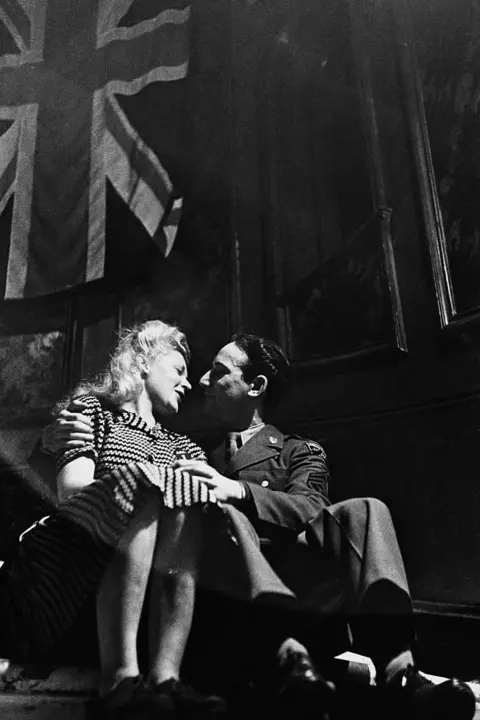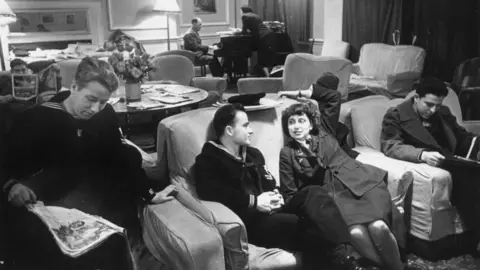Rainbow Corner, the Beaver Club and wartime London
 Getty Images
Getty ImagesFamously overpaid, oversexed and over here - American GIs in World War Two would obviously be in need of somewhere to spend their money, expend their libido and experience some home comforts when they were stationed in the UK.
Many on leave would naturally make their way to London - so, in a busy city with which they were unfamiliar, where would they go for succour?
The answer, for many, was Rainbow Corner.
Set up by the American Red Cross, it was a club just off Piccadilly Circus and between 11 November 1942 and 9 January 1946, it was open 24 hours a day, every day.
Less than half a mile away, Canadian troops had a similar home from home at the Beaver Club.
 Getty Images
Getty Images Getty Images
Getty ImagesAt the opening, the people running Rainbow Corner made a performance of "losing" the key for the front door, symbolising that nobody would be kept out.
But although a locked door wasn't an issue, the London weather provided its own obstacles.
Heavy, dense fog made visibility so poor, 10 American soldiers had to be fished out of the murk by Red Cross staff, and guided to their new recreational club.
 Getty Images
Getty ImagesOn the corner of Shaftesbury Avenue and Denman Street, the five-storey building had been converted over three months into a place for GIs to relax and recuperate.
There were pinball machines, an amusement arcade, pool tables, and a jukebox playing music from home.
The snack bar in the basement, Dunker's Den, sold doughnuts, coffee and Coca-Cola.
Tours were arranged, theatre tickets provided, and dance nights put on - with volunteers brought in to partner the servicemen.
One hostess remembered she embraced the luxuries so unfamiliar to Britons wearied by rationing and war.
"We would go to the soda fountain to have a coke. Sometimes I helped there, and was always amazed to see the syrup which came in barrels become a glass of coke, with ice, which we were not accustomed to.
"It was a very welcome relief after all the dancing we did."
 Getty Images
Getty Images Getty Images
Getty ImagesCanadian troops had a similar facility. Theirs was called the Beaver Club and was in Spring Gardens on Trafalgar Square.
The approach at the Beaver Club was perhaps more focused on home comforts rather than fun.
A system of chaperoning was worked out by a group of Canadian women who happened to live in London.
The ladies assembled a panel of English girls from which partners were selected for dances, theatre parties and sightseeing tours.
There were about 500 women who volunteered such services as mending the soldiers' socks, sewing on buttons and knitting scarves, pullovers "and other comforts".
The attitude was summed up in some of the promotional literature: "Canadian servicemen are always sure of a warm welcome and a good meal at the Beaver Club.
"Everything is done to make things as comfortable and homelike as possible for them."
 Getty Images
Getty Images Getty Images
Getty ImagesThe Beaver Club included a post office, a library with Canadian newspapers, a barber shop, a games rooms stocked with chess and darts.
There were also dining rooms, where "dishes and drinks" were served and troops were allowed to invite girls to parties.
There were extraordinary stories at the Beaver Club - a newspaper report in 1942 described "the silver-haired lady behind the snack bar".
She was Mrs Charles Banks, the wife of a New Zealand-born Canadian gold miner who was in London as an official representative of Canada's munitions and supply ministry.
Mrs Banks had "been everywhere and accompanied her husband on a worldwide quest for gold".
It was alleged in the story that Mrs Banks, while travelling through the jungles of New Guinea, "taught cannibals to wait at tables".
Frustratingly, there seem to be no further details of this particular feat.
 Getty Images
Getty Images Getty Images
Getty ImagesRainbow Corner fully embraced American traditions - holding Halloween and Thanksgiving celebrations, and the BBC would cover what was happening as part of the mutual broadcasting system, so families back in the US could keep updated.
The mutual broadcasting system allowed programmes such as American Eagle In Britain to be relayed to the US as a special facility during the war.
A "dunking doughnuts" competition was covered one year, with full-on sports-style commentary from Capt Ken Treadwell from the US Air Force Special Services Division.
"This is a significant moment in Rainbow Corner history.
"Six members on the stage - competitors will start at whistle signal; first to push doughnuts down and whistle will be champion.
"Number Four already had two doughnuts... but his wristwatch is getting in his way. Number Three getting ready to whistle...Cpl Charles Lytnan of Milwaukee, Wisconsin has won, with Pte Dwight King a close runner-up."
 Getty Images
Getty Images Getty Images
Getty ImagesGwendoline Hollingshead was one of the hostesses, recruited by a girl she met on the Tube.
"She asked me if I could dance. I told her I had taken ballroom dancing classes. She asked me if I would be interested in being a hostess at Rainbow Corner.
"I went for an interview and was accepted - everyone was carefully vetted. My time would be after I had finished work, in the evenings. They gave me an identity card which showed I was a valid member.
"On my first evening on the dance floor, a GI asked me to dance and started jitterbugging, which I couldn't do. Fortunately, I could follow his instructions and picked it up very quickly.
"I had a good time dancing and talking with all servicemen - Air Corps, Infantry and Navy."
 Getty Images
Getty ImagesMs Hollingshead remembered Fred Astaire's sister Adele (Lady Charles Cavendish) helping out.
"She would write letters to their mothers, wives and sweethearts. She was a girl with a big heart.
"Another volunteer, 'Ma' Whittaker, had a plane, Lady Irene, named after her.
"She sewed on over 10,000 stripes, inserting a lucky farthing coin under the stripes for every boy who flies.
"I knew so many boys who went on missions and never returned. This left me with such a sad feeling, as in the main they were really happy-go-lucky guys, and always said how many more missions they had to complete before going home."
 Getty Images
Getty Images Getty Images
Getty ImagesRainbow Corner closed in January 1946. Tens of thousands of GIs, airmen and sailors on leave had passed through its doors.
Now the war was over, and those that survived were on their way home - many with a British girl about to become an American bride.
President Roosevelt's widow, Eleanor, described Rainbow Corner as "the finest example of international cooperation ever seen".
Ms Hollingshead recalled: "VE Day was a wonderful day for us all. So many people - there was singing, dancing, we were all kissing each other, joy beyond belief."
After six years and a day, the Beaver Club closed too.
They had a reception on 19 February 1946, where they sang Auld Lang Syne, 0 Canada, and God Save the King.
It is not known whether the refreshments were served by reformed cannibals.
 Getty Images
Getty ImagesListen to the best of BBC Radio London on Sounds and follow BBC London on Facebook, X and Instagram. Send your story ideas to [email protected]
